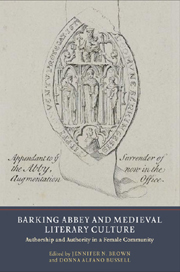Book contents
- Frontmatter
- Contents
- List of Contributors
- Acknowledgements
- List of Abbreviations
- Dedication
- Introduction: Barking's Lives, the Abbey and its Abbesses
- I BARKING ABBEY AND ITS ANGLO-SAXON CONTEXT
- II BARKING ABBEY AND ITS ANGLO-NORMAN CONTEXT
- 5 ‘Sun num n'i vult dire a ore’: Identity Matters at Barking Abbey
- 6 ‘Ce qu'ens li trovat, eut en sei’: On the Equal Chastity of Queen Edith and King Edward in the Nun of Barking's La Vie d'Edouard le confesseur
- 7 Body, Gender and Nation in the Lives of Edward the Confessor
- 8 Clemence and Catherine: The Life of St Catherine in its Norman and Anglo-Norman Context
- 9 Cicero, Aelred and Guernes: The Politics of Love in Clemence of Barking's Catherine
- 10 The Authority of Diversity: Communal Patronage in Le Gracial
- III BARKING ABBEY AND THE LATER MIDDLE AGES
- Afterword. Barking and the Historiography of Female Community
- Bibliography
- Index
- YORK MEDIEVAL PRESS: PUBLICATIONS
10 - The Authority of Diversity: Communal Patronage in Le Gracial
from II - BARKING ABBEY AND ITS ANGLO-NORMAN CONTEXT
Published online by Cambridge University Press: 05 April 2013
- Frontmatter
- Contents
- List of Contributors
- Acknowledgements
- List of Abbreviations
- Dedication
- Introduction: Barking's Lives, the Abbey and its Abbesses
- I BARKING ABBEY AND ITS ANGLO-SAXON CONTEXT
- II BARKING ABBEY AND ITS ANGLO-NORMAN CONTEXT
- 5 ‘Sun num n'i vult dire a ore’: Identity Matters at Barking Abbey
- 6 ‘Ce qu'ens li trovat, eut en sei’: On the Equal Chastity of Queen Edith and King Edward in the Nun of Barking's La Vie d'Edouard le confesseur
- 7 Body, Gender and Nation in the Lives of Edward the Confessor
- 8 Clemence and Catherine: The Life of St Catherine in its Norman and Anglo-Norman Context
- 9 Cicero, Aelred and Guernes: The Politics of Love in Clemence of Barking's Catherine
- 10 The Authority of Diversity: Communal Patronage in Le Gracial
- III BARKING ABBEY AND THE LATER MIDDLE AGES
- Afterword. Barking and the Historiography of Female Community
- Bibliography
- Index
- YORK MEDIEVAL PRESS: PUBLICATIONS
Summary
The multilingualism and multiculturalism of twelfth-century England opened new possibilities for noblewomen's roles in the production and reception of literature. Women, with their long history of cultural and linguistic mobility through marriage, stepped to the fore as authors and patrons. They experimented with the written vernacular and narrative structures that reflected the diversity of contemporary society. To take just two examples, Clemence of Barking authored the Life of Saint Catherine, an adaptation of a hagiographical Latin text, and Constance FitzGilbert patronized the Estoire des Engleis, a vernacular historiography that juxtaposes Saxon, Welsh, Danish and Norman histories. This chapter, however, considers medieval women's literary influence beyond the roles of a single female author or patron, exploring how a female community and discourse could impact on a text. When studying texts that are patronized or influenced by women, it can be especially useful to consider the role and identity of the male cleric in order to understand his approach towards his female patron(s) as well as the access the women had to the text in production.
The Anglo-Norman Marian miracle collection Le Gracial, written in the second half of the twelfth century by Adgar/William, has great significance for multicultural European and women's literature. In this seemingly messy miscellany of octosyllabic verse, continental saints' lives abut accounts of Anglo- Danish relations, and tales of wayward nuns and clerics are interspersed with instructive verses on prayer recitation.
- Type
- Chapter
- Information
- Barking Abbey and Medieval Literary CultureAuthorship and Authority in a Female Community, pp. 210 - 232Publisher: Boydell & BrewerPrint publication year: 2012

